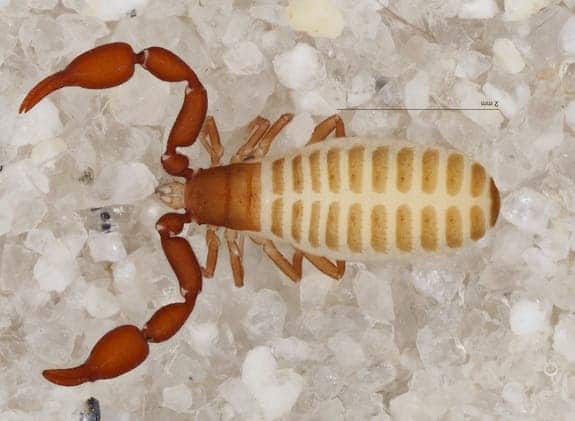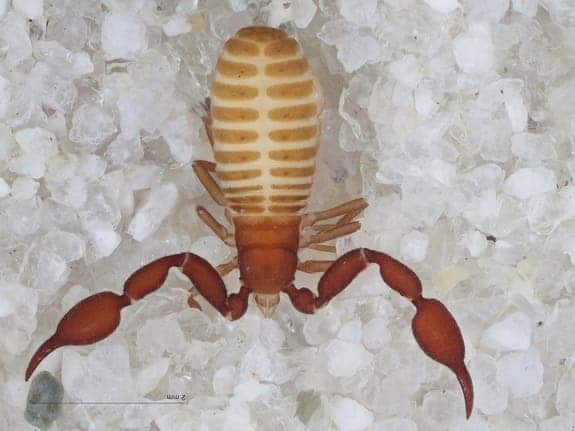Two specially adapted pseudoscorpions have been reported in a cave on the northern side of the Grand Canyon. The creatures, which are not really scorpions, have adapted to their lightless environment by losing their eyes.

Credit: Courtesy of J. Judson Wynne, Northern Arizona University
Unlike true scorpions, pseudoscorpions don’t have a tail with a venomous stinger and are harmless to humans; as a matter of fact, they are often times considered beneficial to humans since they prey on clothes moth larvae, carpet beetle larvae, booklice, ants, mites, and small flies. They are tiny and inoffensive – to small that you usually don’t see them.
Researchers first discovered the pseudoscorpions in 2006, but it wasn’t until now that they were able to show that these are actually new species. That’s usually how it goes – you find a species, but it takes quite a while to show that it’s a new one.
“Contrary to popular belief, rarely are we in the field, collect an animal and then brandish our grubby field flasks of whiskey to toast a new species discovery,” J. Judson Wynne, an assistant research professor in the Department of Biological Sciences at Northern Arizona University, in Flagstaff in an email.
The cave in which the specimens were discovered measures 76 meters (250 feet) in length, but it hosts a striking biodiversity. Typically, animals living in caves have special adaptations to survive in the light-less environment with constant temperatures. It’s not uncommon to see cave dwelling animals to lose eye sight or have their skin turn completely pink. This was the case with the pseudoscorpions as well.

Credit: Courtesy of J. Judson Wynne, Northern Arizona University
A taxonomic analysis revealed that one of the species also had a thickened pair of legs and a mound on the pincer, while another had a much deeper pincer than other pseudoscorpions. The creatures, which are about 0.12 inches (3 millimeters) long and feed on tiny invertebrates were called Hesperochernes bradybaughii and Tuberochernes cohni, respectively. Much of their prey is much smaller than the tip of a matchstick.
The fact that these creatures can survive in caves suggest a very well developed food web. At some point in their evolution, pseudoscorpions were hunting small insects in the desert, but since they’ve moved “indoors”, their bodies have become longer and switched their diet. Researchers believe that these pseudoscorpions often eat the cricket “frass,” or poop, as well as the fungus that grows on the poop. They haven’t stopped hunting, though it’s not clear how this process goes without eyes. Probably their other senses became more keen to compensate for the loss of sight.
As for how they got in the cave in the first place, that’s another good question. The answer probably lies in their pincers – which are good not only for grabbing prey, but for hitchhiking on other creatures.
“They will grasp onto another animal such as birds, mammals and even other insects. They hold on and can be transported long distances,” Wynne said.
This allows them to spread much more than they could on their own, and they provide no disadvantage for the host – on the contrary, they prey on its common parasites such as fleas or mites. It’s plausible that the pseudoscorpions got into the cave by hitchhiking another creature that went into the cave. This likely happened thousands or tens of thousands of years ago.






